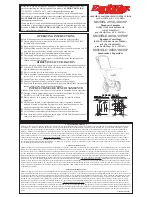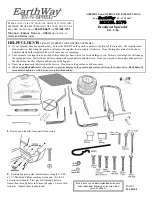
27
8. MAINTENANCE, CARE AND STORAGE
When the work season is over, do the following:
- wash the spreader;
- repair all paint coat decrements;
- lubricate all lubrication points;
- protect all quick-release couplings of the hydraulic system from contamination (e.g. by wrapping in foil);
- check all threaded and pin connections (re-tighten or repair as required);
- after lifting the spreader above the ground and setting it on the props, reduce the tyre pressure by approx.
0.1-0.15 MPa (1-1.5 atm);
- check the transmission oil level and refill to the bottom edge of the filling port;
- clean and preserve the telescopic jointed shaft;
- identify all parts which need to be replaced;
- store the machine under a roof if possible.
Before attempting to work on any systems of the spreader connected to the tractor with the
drive-shaft, turn off the tractor engine, remove the ignition key and engage the tractor parking
brake.
Decouple the drive-shaft before servicing (cleaning, maintenance, repairs) the machine.
Engage the spreader parking brake and chock the wheels.
Open the upper wall to enable entering and exit from load body when entering the body
using the ladder to perform maintenance.
9. DISMANTLING, DISPOSAL AND ENVIRONMENTAL
PROTECTION
If the product is repaired, dispose of all worn-out parts at a scrap collection point. Follow all applicable OHS
regulations for repair and replacement of worn-out subassemblies. Dispose of the entire product at a recyclable
materials collection point.
Each identified hydraulic system fault, i.e. oil leaks, must be immediately rectified to prevent environmental
pollution. Do not let the oil to be spilled on the ground when replacing the fluid. Store the used oil in sealed vessels
(e.g. used for fresh oils) and periodically dispose of its at fuel stations.
Only the personnel experienced in the design and operation of the machine is authorised to dismantle
it. Follow the general safety precautions for agricultural equipment servicing during disassembly (repairs).
Due to the large weight of components (over 20 kg), use suitable lifting equipment for disassembly.
Do not leave any worn-out or damaged parts from repairs or disposal on the field or farm premises. Such
items must be stored at a designated area (with restricted access of personnel and animals) and periodically
disposed of at a scrap collection point.
Dispose of the entire machine at a specialist facility which handles the dismantling of machines and equipment.
If disposing of the machine on your own, segregate all dismantled components in accordance to the material type:
rubber, ferrous metals and non-ferrous metals. Submit all rubber parts for re-use (recycling or disposal).
Summary of Contents for N280
Page 4: ...4 Nameplate...
Page 12: ...12...
Page 13: ...13 Fig 1 Locations of the information and warning signs...






































